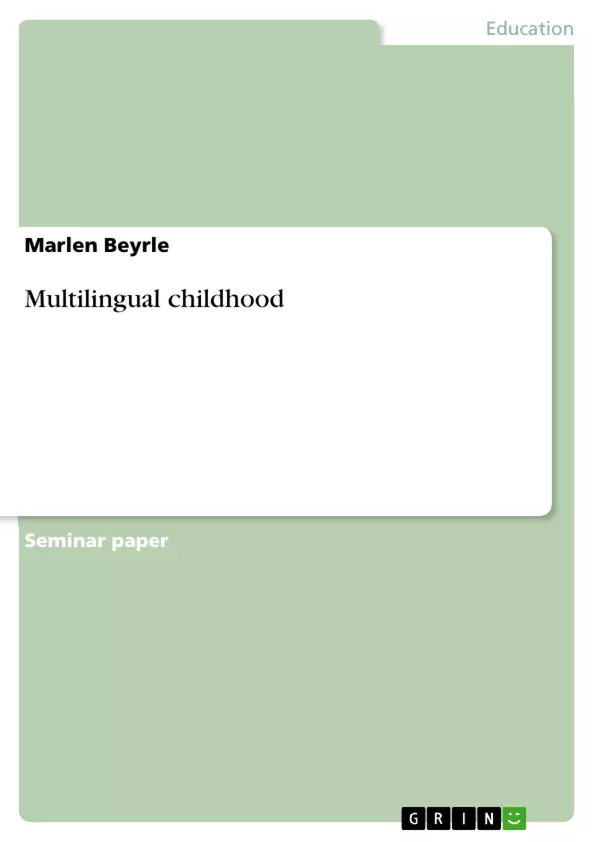The acquisition of the language begins with the birth of the child. The first years of life are the basis for language acquisition. During this time, children can effortlessly learn their mother tongue and, if necessary, a second language. It is therefore important to support the children in this phase of their lives in their language development. As educators, we play a big role in this. It is a central elementary educational task for us.
The dialogue between mother and child begins in the womb. The child responds to familiar voices. The parents' body language, timbre and intonation convey feelings and moods that the child understands long before it can speak. This is one of the reasons why later it is important for some children to speak in their mother tongue/first language. They associate certain feelings with it. It conveys security when you hear or speak this language. I chose the topic "multilingualism" because it has interested me for a long time and I think that it already plays an important role and will play an even more important role in the near future. In class, I was able to get my first impressions of this topic.
Inhaltsverzeichnis (Table of Contents)
- Introduction
- What is language?
- Definition of language
- Language as an educational process
- Child language development
- How children learn to speak
- The phases of language acquisition
- Basic knowledge of multilingualism
- What is multilingualism?
- Double language acquisition
- Child's second language acquisition
- Language acquisition of a second language in childhood
- The importance of the first language and the associated development of identity
- The first language as a basic framework for the acquisition of the second language
- How children learn a second language
- Possible difficulties in learning a second language
- Language acquisition of two languages after birth
- The phases of double language acquisition
- Bilingual education
- Which language is preferred when children grow up bilingual?
- Using multilingualism as an opportunity
- Normality Multilingualism
- Seeing multilingualism as an opportunity for development
- Dealing with multilingualism in children with a migration background in kindergarten and school
- Multilingual children are often children with a migrant background
- Language support for children with a migration background
- Language development instead of language teaching for children with a migration background
- A practical way of promoting language skills in the sense of language development
- Intercultural pedagogy in support of multilingualism
- Intercultural pedagogy
- Foundations of intercultural pedagogy
- Prejudice-conscious education
- Conclusion of intercultural education in support of multilingualism
- Projects from practice
- Project for early language support for children with a migration background
- Project "Open languages: Life at the intersection of cultures"
- Promotion of Turkish-speaking children
Zielsetzung und Themenschwerpunkte (Objectives and Key Themes)
This work aims to explore the significance of multilingualism and its impact on children, particularly those with a migration background. It examines the process of language acquisition, both first and second language, within the context of early childhood education.
- The importance of language development in early childhood
- The benefits and challenges of multilingualism
- Supporting multilingual children, especially those with a migration background
- The role of intercultural pedagogy in fostering multilingualism
- Practical projects and initiatives for promoting language skills in diverse learners
Zusammenfassung der Kapitel (Chapter Summaries)
The introduction highlights the importance of language for communication and interaction, emphasizing the early years as crucial for language acquisition. The definition of language is explored, emphasizing its role in emotional expression and cognitive development. Chapter 3 delves into child language development, focusing on the stages of language acquisition and the factors influencing this process. The concept of multilingualism is introduced in Chapter 4, exploring the acquisition and challenges of second language learning in children. Chapter 5 examines the specific case of language acquisition in children with a migration background, discussing the impact of their first language and the need for appropriate language support. Chapter 6 explores intercultural pedagogy and its significance in promoting multilingualism and inclusivity in early childhood education.
Schlüsselwörter (Keywords)
Multilingualism, early childhood education, language acquisition, migration background, intercultural pedagogy, language development, language support, second language learning, bilingual education.
- Quote paper
- Marlen Beyrle (Author), 2007, Multilingual childhood, Munich, GRIN Verlag, https://www.grin.com/document/1170827



